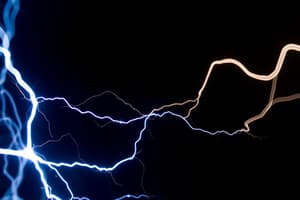Podcast
Questions and Answers
What does Coulomb's law describe?
What does Coulomb's law describe?
How does the force between two point charges change if they have opposite signs?
How does the force between two point charges change if they have opposite signs?
In Coulomb's law, what does 'r' represent in the formula?
In Coulomb's law, what does 'r' represent in the formula?
Which fundamental principles are combined to derive Coulomb's law?
Which fundamental principles are combined to derive Coulomb's law?
Signup and view all the answers
What determines the direction of the electrostatic force between two point charges?
What determines the direction of the electrostatic force between two point charges?
Signup and view all the answers
What are some common applications of Coulomb's law?
What are some common applications of Coulomb's law?
Signup and view all the answers
How has Coulomb's law impacted the development of our understanding of electromagnetic phenomena?
How has Coulomb's law impacted the development of our understanding of electromagnetic phenomena?
Signup and view all the answers
What is one way in which researchers are currently exploring the application of Coulomb's law in explaining more complex situations?
What is one way in which researchers are currently exploring the application of Coulomb's law in explaining more complex situations?
Signup and view all the answers
In what scientific disciplines do the applications of Coulomb's law extend?
In what scientific disciplines do the applications of Coulomb's law extend?
Signup and view all the answers
How does Coulomb's law contribute as a foundational tool in classical physics related to electromagnetism?
How does Coulomb's law contribute as a foundational tool in classical physics related to electromagnetism?
Signup and view all the answers
Study Notes
Electric Field and Charges: Understanding Coulomb's Law
Coulomb's law is one of the fundamental principles of electricity and magnetism, which deals with how electric fields behave near charged particles or objects. It provides a mathematical description of the relationship between these charged elements and their surrounding environment, often referred to as an 'electric force.' This law was established by Charles Augustin de Coulomb around 1785 while working on developing precision instruments. Here we will explore some of the key aspects of this important principle.
What Is Coulomb's Law?
In its simplest form, Coulomb's law states that two point charges interact with each other through an electrostatic force acting along the line connecting them. This force has both magnitude and direction, with the latter being determined by the relative positions of the charges. If they have opposite signs, the force will act to bring the charges closer; if of like sign, it will repel them apart. In terms of mathematics, the formula for Coulomb's law is given by [F = \frac{kq_1 q_2}{r^2},] where (F) is the force between point charges (q_1) and (q_2,) separated by distance (r.)(k) is known as Coulomb constant and depends upon the medium through which the charge moves.
Derivations and Applications
The derivation of Coulomb's law comes from combining Newton's second law of motion ((F=ma)) with Gauss's theorem and Maxwell's equations. These principles allow us to determine how electrical forces operate within a vacuum and also when there are other factors influencing them such as dielectrics, magnetic materials etc. Some common applications of Coulomb's law include calculating the force needed to move an electron away from the nucleus of an atom, designing antennas and wires used in radio transmitters, and manipulating charged molecules during chemical reactions.
Consequences and Future Prospects
Coulomb's law has had significant consequences in the development of our understanding of electromagnetic phenomena, including the evolution of quantum mechanics and relativity theories. Currently researchers continue to investigate ways in which it can help explain more complex situations involving multiple bodies interacting together over time. For instance, theories exist looking at how multiple bodies might experience gravitational attraction via a similar mechanism as described by Coulomb's law. As technology continues to advance, new fields may emerge based on the workings of this powerful physical concept.
In summary, Coulomb's law serves as a foundational tool in the study of classical physics related to electromagnetism. Its applications range widely across various scientific disciplines allowing for advancements in the study of matter itself.
Studying That Suits You
Use AI to generate personalized quizzes and flashcards to suit your learning preferences.
Description
Explore the fundamental principle of Coulomb's law, which describes the behavior of electric fields near charged particles or objects. Learn about the mathematical relationship between charges and their environment, as established by Charles Augustin de Coulomb in the 18th century.




